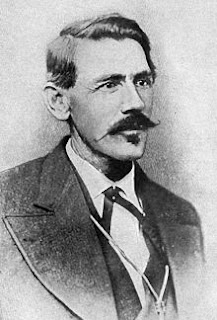John Whalen (writing as John M. Whalen) is
the author of ‘hybrid’ novels where the western meets the future, or the lone
gunman hero is as likely to encounter vampires or monsters as regular bad guys.
John
tells me he likes THE BIG SHUTDOWN
because ‘it was my first attempt at a Space Western… It gave me room to stretch
out.’
Across the desolate Planet Tulon Jack
Brand, former officer in the Tulon Security Force, is on a lone search. Seven
years ago his sister, Terry, was kidnapped by the Wilkersons, a nomadic outlaw
gang. Brand has sworn never to leave Tulon until he finds her. But time is
running out. The energy conglomerates that own Tulon are shutting the planet
down, although it’s still rich in oil. Soon the last ships will leave for
Earth.
Brand travels from desert wasteland
to steaming jungles, from a city at the bottom of the sea to a desert town run
by alien gangsters. He battles the many perils of Tulon with his quick wits,
fast reflexes, and the Electro-Pistol holstered to his hip.
Ostensibly
re-running the 1960 Randolph Scott western COMANCHE STATION in space, John soon
whisks us off into completely new territory.
Also included is an additional story from John's "This Raygun for Hire." series, featuring Frank Carson, a futuristic trouble shooter for hire.
Nancy
Gates and Randolph Scott in ‘Comanche
Station (1960)’
A lost
sister – kidnapped by Comanches - features in THE SEARCHERS (1956), of course.
Brother
and sister (Jeffrey Hunter and Natalie Wood) re-united in ‘The Searchers’
And in
the world of TV Westerns the whole premise of the 1976 series THE QUEST was
about two brothers searching for their sister after she was carried off by the
Cheyenne.
Kurt Russell and Tim Matheson search for their lost sister in ‘The Quest’
Once
again I’d reference my contender for best TV Western episode ever: THE HIGH CHAPARRAL episode ‘Ride
the Savage Land.’ Having rescued one white girl from the Apaches holding her captive, the High Chaparral crew attempt to rescue her sister (Claire Wilcox,
pictured) from them also.
The
dystopian future elements of THE BIG
SHUTDOWN reminded me of movies from MAD MAX (anarchy in a society depending on oil)
Mel
Gibson in ‘Mad Max’ (1979)
to
OUTLAND (1981.)
Reviews
of THE BIG SHUTDOWN:
‘Readers
are in for a rootin' tootin' fun ride… will remind readers just why pulp
fiction, westerns, and ray guns belong together.’
‘Quick,
thrilling, and at times quite thoughtful.’
‘Recommended
for space opera/space western fans of all ages.’
https://www.amazon.com/Big-Shutdown-John-Whalen-ebook/dp/B017ME7YXC and https://www.amazon.co.uk/Big-Shutdown-John-Whalen-ebook/dp/B017ME7YXC





































